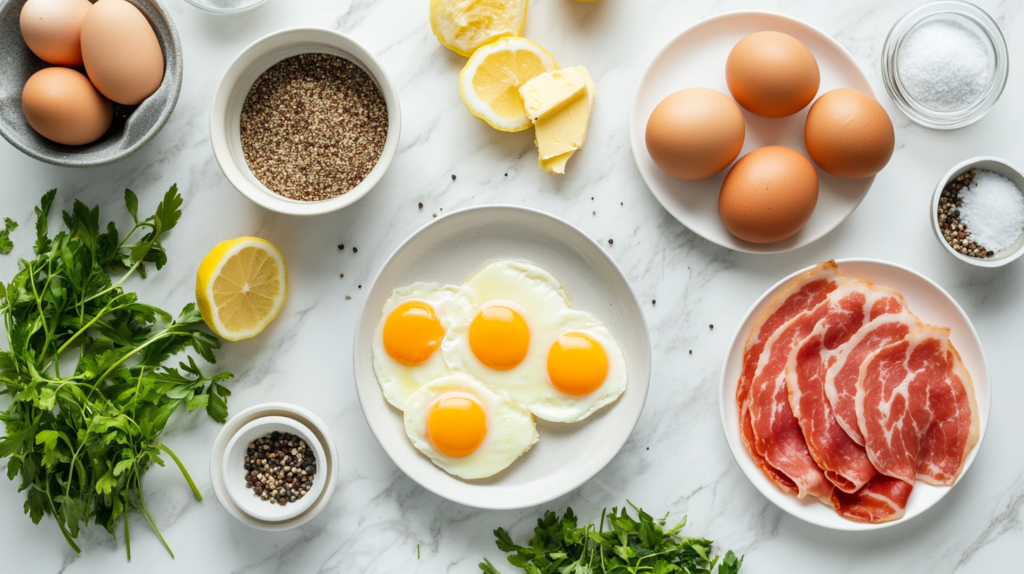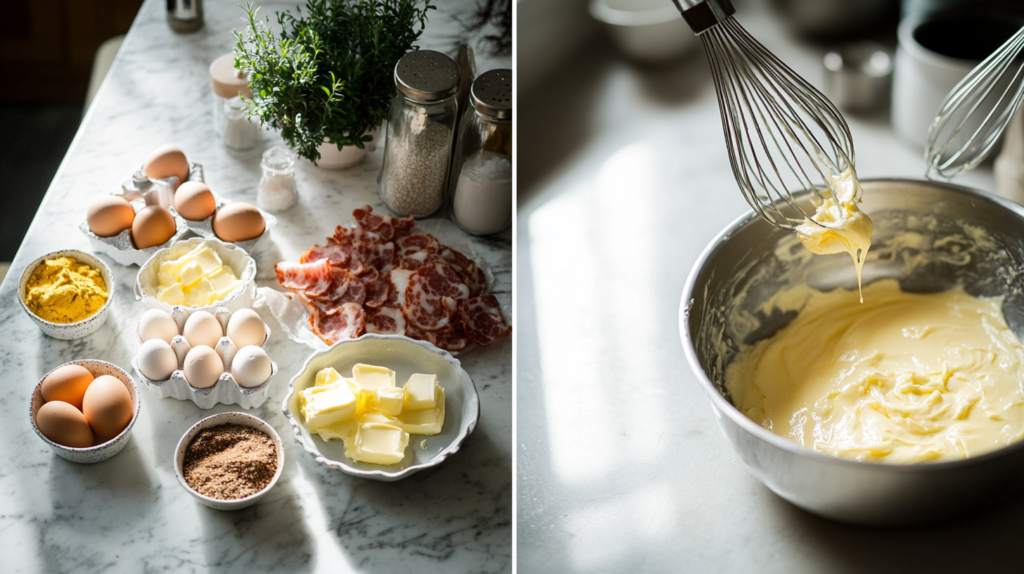If there’s a dish that screams “fancy brunch” louder than a towering plate of Eggs Benedict, I haven’t met it yet. There’s something so satisfying about slicing into a poached egg, watching the golden yolk spill out, and catching it all with a buttery English muffin and smoky Canadian bacon.
The good news? You don’t have to book a table at a fancy café to enjoy it. With a little patience (and a few tricks), you can create restaurant-quality Eggs Benedict right in your own kitchen. Let’s crack into it!
Table of contents
- What Is Eggs Benedict? A Brunch Icon
- Why You’ll Love This Eggs Benedict Recipe
- Essential Ingredients for the Perfect Eggs Benedict
- How to Make Eggs Benedict Step-by-Step
- Common Problems and Easy Solutions
- Creative Variations on Classic Eggs Benedict
- Make-Ahead Tips for Stress-Free Brunch
- Serving Suggestions and Brunch Pairings
- Frequently Asked Questions (FAQs)
- Discover More Delicious Breakfast and Brunch Recipes
- Conclusion: Mastering Eggs Benedict at Home
What Is Eggs Benedict? A Brunch Icon
Eggs Benedict is a classic American breakfast or brunch dish that layers together toasted English muffins, Canadian bacon, perfectly poached eggs, and rich, buttery Hollandaise sauce.
It’s luxurious yet surprisingly simple once you break down each component.
Think of it like a symphony: when every part is tuned just right, it’s pure magic.
“Eggs Benedict is brunch’s version of a love letter — rich, delicate, and best served warm.”
It’s elegant without being complicated, which is why it’s remained a favorite on brunch menus around the world.
The History Behind the Dish
The true origin story of Eggs Benedict is a little murky (and deliciously dramatic).
Some say it was invented in the late 1800s at Delmonico’s in New York. Others credit a hungover Wall Street broker named Lemuel Benedict, who supposedly ordered a concoction of toast, poached eggs, bacon, and Hollandaise sauce to cure his morning-after blues.
Wherever it came from, one thing’s for sure: we owe someone a huge thank you for this creation.
Why You’ll Love This Eggs Benedict Recipe
So, why bother making Eggs Benedict at home instead of ordering it out? Oh, let me count the ways:
A Crowd-Pleasing Classic
Whether you’re hosting a lazy Sunday brunch or a special occasion breakfast, Eggs Benedict feels festive without being fussy.
It’s one of those dishes that instantly makes your guests feel pampered and impressed — even though you know it’s really not that hard!
And let’s be honest — poached eggs and buttery sauce? Who’s saying no to that?
Versatile for Creative Variations
One of the best things about Eggs Benedict is how easily you can switch it up.
Not a fan of Canadian bacon? Swap in smoked salmon.
Want a vegetarian version? Add sautéed spinach for a Florentine twist.
The foundation stays the same: muffin + something tasty + egg + sauce = instant brunch hero.
“Eggs Benedict is like a blank canvas — once you master the basics, you can paint it with whatever flavors you love most!”
No matter how you personalize it, that rich combo of textures and flavors is guaranteed to impress.
Essential Ingredients for the Perfect Eggs Benedict

Eggs Benedict is a dish of layers, and every layer counts. 🧡
Here’s what you’ll need to pull off a stunning, brunch-worthy plate:
- Fresh eggs (the fresher, the better for easier poaching)
- English muffins (buttery, soft inside with a slight crisp outside)
- Canadian bacon (or ham, prosciutto, or even smoked salmon)
- Butter (for the Hollandaise sauce)
- Egg yolks (also for the Hollandaise)
- Lemon juice (fresh, to brighten the sauce)
- Salt and pepper
- Optional garnishes: fresh herbs like chives or parsley 🌿
Trust me, a few good-quality ingredients make all the difference!
Choosing Quality Eggs and English Muffins
Fresh eggs are your best friend when it comes to poaching. 🥚
Older eggs tend to spread out too much in the water, while fresher eggs hold their shape beautifully.
As for English muffins, look for ones with a good “nook and cranny” texture. That way, all the runny yolk and silky Hollandaise have somewhere to pool — pure heaven!
The Role of Canadian Bacon (or Substitutes)
Traditional Eggs Benedict uses Canadian bacon, which is leaner than American-style bacon and has a lightly smoky flavor.
You can swap it out for:
- Smoked salmon (making it Eggs Royale)
- Sautéed spinach (for a vegetarian Eggs Florentine)
- Crispy pancetta or even a juicy tomato slice 🍅
“The beauty of Eggs Benedict is that it can be as classic or creative as you want it to be.”
Hollandaise Sauce: The Star of the Show
Hollandaise sauce is what ties everything together — it’s creamy, buttery, lemony, and just the right amount of indulgent. 🍋
It’s an emulsion of egg yolks, melted butter, and lemon juice, whisked to silky perfection.
Yes, it sounds fancy, but you don’t need to be a Michelin-star chef to pull it off (promise!).
I’ll guide you through it in the next section.
How to Make Eggs Benedict Step-by-Step
Alright, let’s roll up our sleeves and make some brunch magic happen! 🎩✨
Preparing the Hollandaise Sauce
First things first — Hollandaise is best made right before serving.
- In a heatproof bowl, whisk 3 egg yolks and 1 tablespoon of lemon juice until combined.
- Place the bowl over a pot of simmering water (double boiler style).
- Whisk constantly until the yolks thicken slightly.
- Slowly drizzle in ½ cup melted butter, whisking all the while until the sauce thickens.
- Season with a pinch of salt and a little more lemon juice if needed.
If the sauce looks too thick, whisk in a teaspoon of warm water to loosen it.
Pro Tip: Keep the heat low and move quickly — you’re coaxing the eggs into thick, glossy submission, not scrambling them! 🥄
Poaching the Perfect Egg
Poaching can sound intimidating, but with a few tricks, it’s honestly easy:
- Fill a wide saucepan with 2–3 inches of water and bring it to a bare simmer.
- Add a splash of vinegar (it helps the egg whites firm up faster).
- Crack your egg into a small bowl first.
- Gently slide the egg into the water.
- Cook for about 3–4 minutes, until the whites are set but the yolk is still soft.
Use a slotted spoon to lift the egg out and drain on paper towels.
“Poached eggs are like little clouds — gentle handling and patience will reward you with perfection.”
Assembling Your Eggs Benedict Like a Pro
Now for the fun part! 🧡
- Toast your English muffin halves until golden brown.
- Warm your Canadian bacon slices in a skillet.
- Top each muffin half with a slice of bacon.
- Carefully place a poached egg on top.
- Spoon that luscious Hollandaise sauce generously over everything.
Garnish with chopped chives, parsley, or a sprinkle of paprika if you’re feeling fancy!
Stand back and admire your creation — you’ve just made restaurant-quality Eggs Benedict at home!
Common Problems and Easy Solutions
Even though Eggs Benedict feels fancy, it doesn’t have to be stressful. Let’s tackle the common mistakes so you can plate up like a pro every time. 💪
Why Is My Hollandaise Sauce Too Thin or Broken?
If your Hollandaise sauce is runny or has separated, it’s usually because:
- The butter was added too quickly.
- The heat was too high and cooked the eggs.
- The sauce cooled down too much before finishing.
Solutions:
- Add melted butter very slowly, whisking constantly.
- Keep the heat low and gentle.
- If your sauce breaks, whisk in a tablespoon of hot water — it often pulls it back together.
“Making Hollandaise is like making magic — gentle heat, slow movements, and a little faith!” ✨
Troubleshooting Poached Egg Issues
Poached eggs falling apart? Whites going wild in the pan? Here’s why:
- The water was boiling too hard (gentle simmer is key).
- The eggs weren’t fresh (older eggs have watery whites).
Solutions:
- Use the freshest eggs possible.
- Create a small “whirlpool” by stirring the water before dropping in the egg — it helps the whites wrap around themselves!
How to Prevent Soggy Muffins
Nobody wants soggy muffins under their glorious poached eggs. 😬
Tips:
- Toast the English muffins until they’re nicely crisp.
- Drain poached eggs well on paper towels.
- Don’t over-sauce — drizzle, don’t drown!
Creative Variations on Classic Eggs Benedict
Mastered the classic version? Let’s have some fun!
Smoked Salmon Benedict (a.k.a. Eggs Royale)
Swap the Canadian bacon for silky smoked salmon.
It’s rich, luxurious, and absolutely perfect for special occasions.
Top it off with a sprinkle of fresh dill or capers for extra elegance.
Florentine Benedict (with Spinach)
Sauté a handful of fresh spinach with a little butter and garlic.
Pile the spinach onto the muffin before adding your egg.
It’s a wonderful vegetarian option — and you get to feel virtuous eating your greens.
Avocado or Crab Cake Benedict
For a trendy twist:
- Replace the muffin with a slice of toasted sourdough and top with smashed avocado.
- Or swap the bacon for a crispy crab cake for a coastal vibe!
“Eggs Benedict is like a brunch passport — one base recipe, endless delicious destinations!”
Make-Ahead Tips for Stress-Free Brunch
Hosting brunch doesn’t have to mean running around like a headless chicken!
Can You Make Hollandaise Sauce Ahead of Time?
Hollandaise is best fresh, but you can keep it warm for up to 1 hour.
Place it in a thermos or keep it in a double boiler over very low heat.
If needed, you can also make a “blender Hollandaise” that holds up a little better.
How to Reheat Poached Eggs Without Overcooking
- Cook and shock the poached eggs in ice water.
- When ready to serve, reheat gently in hot (not boiling) water for 30–60 seconds.
Your eggs will stay soft and dreamy without turning rubbery!
Serving Suggestions and Brunch Pairings
Want to create the ultimate brunch spread? Here’s how to build a meal around your Eggs Benedict:
Best Side Dishes for Eggs Benedict
- Crispy hash browns or roasted potatoes 🥔
- Fresh fruit salad
- Mixed greens with a light vinaigrette
Drinks That Complement Your Brunch
- Freshly brewed coffee ☕
- Mimosas or sparkling wine 🍾
- Freshly squeezed orange or grapefruit juice 🍊
Create a simple but elegant table and you’ll have a brunch that feels like it came straight from a magazine!

Frequently Asked Questions (FAQs)
Can I Freeze Hollandaise Sauce?
Not really.
Hollandaise doesn’t freeze well because it’s an emulsion and tends to separate when thawed. It’s best made fresh (or kept warm short-term).
What’s the Best Vinegar for Poaching Eggs?
Use a mild white vinegar — it helps the egg whites set faster without adding any flavor.
How Long Can Poached Eggs Be Stored?
Cooked poached eggs can be stored in ice water in the fridge for up to 2 days.
Just reheat gently in hot water before serving.
Discover More Delicious Breakfast and Brunch Recipes
If you enjoyed this classic Eggs Benedict Recipe, you’ll love exploring more easy and delicious breakfast ideas from our kitchen:
- Add another savory option with this hearty sausage quiche recipe, perfect for weekend brunch.
- Start your morning right with these flaky breakfast croissant recipe.
- For a lighter option, check out the protein-packed egg white bites recipe.
- Want something refreshing to sip with your meal? Try our nutritious carrot juice recipe.
- Craving even more healthy and delicious starts? Explore these salmon breakfast recipes.
👉 Browse even more tasty breakfast and brunch inspirations at Call Me Recipes!
Conclusion: Mastering Eggs Benedict at Home
Eggs Benedict may look impressive (and let’s be real, it is), but it’s absolutely doable at home once you break it down into simple steps. 🥚🍋🍞
It’s a dish that’s all about small details — fresh eggs, creamy Hollandaise, toasted muffins — and when you get those right, the result is pure brunch bliss.
“Eggs Benedict isn’t just breakfast — it’s a celebration you can create with your own two hands.”
So go ahead: gather your ingredients, take a deep breath, and get ready to wow yourself (and everyone lucky enough to be at your table)!

